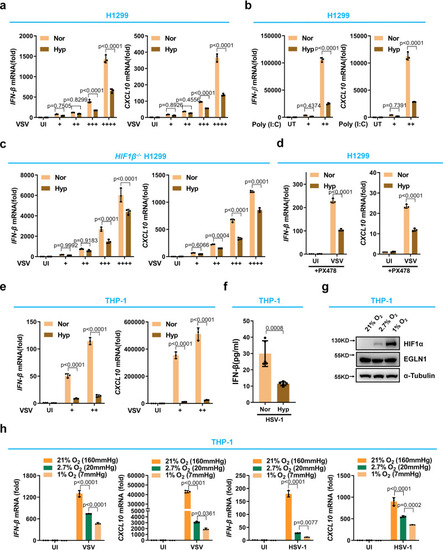|
Hypoxia suppresses antiviral gene expression in response to viral infection independently of HIF signaling. a qPCR analysis of IFN-β and CXCL10 mRNA in H1299 under normoxia (21% O2) or hypoxia (1% O2), infected without (UI) or with increasing amounts of VSV (+, 0.2 MOI (Multiplicity of Infection); ++, 0.5 MOI; +++, 1.0 MOI; ++++, 2.0 MOI) for 8 h. b qPCR analysis of IFN-β and CXCL10 mRNA in H1299 under normoxia (21% O2) or hypoxia (1% O2), transfected without (UT) or with increasing amounts of poly (I:C) (+, 0.5 μg/ml; ++, 1.0 μg/ml) for 8 h. c qPCR analysis of IFN-β and CXCL10 mRNA in HIF1β−/− H1299 under normoxia (21% O2) or hypoxia (1% O2), infected without or with increasing amounts of VSV (+, 0.2 MOI; ++, 0.5 MOI; +++, 1.0 MOI; ++++, 2.0 MOI) for 8 h. d qPCR analysis of IFN-β and CXCL10 mRNA in H1299 treated with PX478 (10 μM) under normoxia (21% O2) or hypoxia (1% O2), infected without or with VSV for 8 h. e qPCR analysis of IFN-β and CXCL10 mRNA in THP-1 under normoxia (21% O2) or hypoxia (1% O2), infected without or with increasing amounts of VSV (+, 1.0 MOI; ++, 2.0 MOI) for 8 h. f ELISA assay of IFN-β in THP-1 under normoxia (21% O2) or hypoxia (1% O2), infected with HSV-1 for 8 h. g Immunoblotting of HIF1α protein in THP-1 under physiological oxygen pressures (21% O2 (≈160 mmHg O2), 2.7% O2 (≈20 mmHg O2) and 1% O2 (≈7 mmHg O2)). h qPCR of IFN-β and CXCL10 mRNA in THP-1 under physiological oxygen pressure (21% O2, 2.7% O2 and 1% O2), infected without or with VSV (left two panels) or HSV-1 (right two panels). Data in (a–e, h) are presented as mean ± S.D., two-way ANOVA; n = 3 biological independent experiments. Data in (f) are presented as mean ± S.D., two-tailed Student’s t test; n = 5 biological independent samples. Data in (g) are representative from three independent experiments. See also Supplementary Fig. 1. Source data are provided as a Source data file.
|

